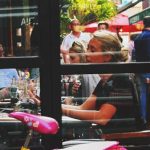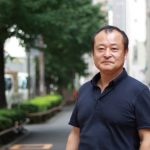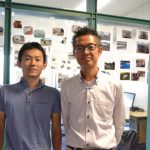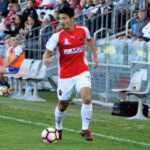台北に行ってきました!!
公開:2017-09-25 更新:2019/04/08
{English version below} 皆さん、お久しぶりです! 今回は、最近旅行で行った台湾についてです。 今年の6月に3泊4日で、台湾の首都、台北に行ってきました。 日本を除いてアジア圏の国への旅行は初めてだったので、この体験が台湾へ留学したい人の参考になればと思います。きっと留学でもはじめて旅行で訪れる国での体験と同じように、カルチャーショックなどを経験するはずだからです。
それでは、まず美しい台北について!
台北は国際的な都市です。中国の文化が先住民の文化と混じり、日本、東南アジアやアメリカの影響も受けています。このような活気に満ちた町は、夜市(ナイトマーケット)やお茶で有名です。 夜市とは夕方5時から深夜0時ごろまでの市場のことです。その特徴は、いろいろな美味しい台湾料理「Xiaochi」、つまりストリートスナック(屋台料理)です。その中でも一番人気はフライドチキン、「刈包」、Stinky tofu, 牛丼、Bubble milk tea, パイナップルケーキ、「Ba wan」などです。安くておいしい夜市は観光客だけではなく地元の人にも人気なので、いつも混んでいます。

通化夜市
また、台湾はお茶の生産国としても有名です。台湾のBau Jong Teaとウーロン茶は世界中に流通しています。そのため、台北には多くの喫茶店があります。私はその中でも人気の「Water Moon Tea House」に行ってきました。そこでは店員さんが台湾式の茶道を教えてくれ、おいしいお茶と台湾のお菓子がいただけました。日本の茶道を経験したことがある私にとって、それは面白くて、興味深い経験で、ビデオをたくさん撮りました。

有名な「Water Moon Tea House」
台北のお寺
台北に滞在中には、以下のお寺にも訪れ、台湾の伝統についていろいろと学びました。
- ◆1760年に創立された「大龍?保安宮」は2003年にユネスコの「アジア太平洋文化資産保存賞」を受賞し、素敵な台湾風の飾りで装飾されています。毎年保安宮では民俗行事「保生文化祭」が行われ、台湾の宗教、文化や建築芸術を紹介しています。

大龍?保安宮
- ◆保安宮の隣には、「台北孔子廟」があります。1879年に中国本廟を基にして建てられましたが、日本統治時代に取り壊され、1920年代の終わりになってもう一度建てられました。特徴としては「?南」スタイルと福建風陶器の飾りです。
- ◆「龍山寺」は万華区にあり、1730年代頃に創立されたお寺です。上の2つのお寺と同じように、台湾風の建築術は南中国のスタイルから影響を受けました。

龍山寺
- ◆他には「艋舺青山宮、松山慈祐宮、台北天后宮」などにも行きました。中でも私が一番好きだったのは天后宮でした。西門町の多くのお店の間に隠されており、ちょっと見つけにくいかもしれませんが、本当に素敵な聖なる場所でした。他のお寺と比べると小さいのですが、天井に掛かっているたくさんの赤いカンテラが神秘的な雰囲気を作り出していました。面白いと思ったことは、このお寺には中国の神様と日本の神様の両方が祀られていたことです。
これらの寺院に行った時に、私はすごく驚きました。それは、日本のお寺と違って台北のお寺は中国のスタイルを基に建てられたので、日本のとは違い派手な色や飾りがあったからです。よく見られた装飾は中国風の伝統的な竜です。また、日本のお寺は一般的に静かな場所である気がしますが、台北のお寺は地元の人が集まる場所で、いつも賑やかで一日中お参りに来る人が見受けられました。美しいお花や野菜、果物、またその他の食べ物など色々な物がお寺へ奉納物として置かれています。

お花はお寺へ奉納物として置かれている。
他の有名な観光地!
お寺以外で私がお勧めしたい場所は、中正紀念堂や自由広場、忠烈祠、迪化街 、台北101です。
- ◆自由広場は24万平方メートル広さがあり、いろいろなイベントやコンサートなどが開催されます。中正紀念堂は広場の東端にあり、中には中世や台湾の歴史に関する展示を見ることができます。

自由広場門

自由広場にある中正紀念堂
- ◆国民革命忠烈祠はさまざまな戦争で亡くなった英霊を祀っています。衛兵交代のセレモニーで有名で、日本人旅行者にとても人気です。
- ◆迪化街は歴史的な商店街で、昔は台北の商業の中心地でした。商品の中では、中国の薬草、台湾のお茶、織物や香料が現在も売られています。

迪化街の店
- ◆台北101を始めて見た時に、東京スカイツリーを思い出しました。台北101は2010年まで世界で一番高い建物でした。88階と89階は屋内展望台で、91階は屋外展望台です。そしてなんと101階はVIPクラブです。

台北101 – Taipei 101
このように、台北に着いた時、少しカルチャーショックを感じました。 日本の生活に慣れてきた私には、台北は人やものが溢れた町に感じ、全然中国語がわからない私は何度も道に迷いました。英語が話せない人が多いみたいですが、面白いことにホテルのスタッフは日本語が話せました。 特に、私にとって一番難しかったのは夜市で屋台のごはんを試すことでした。なぜかというと、私は屋台のごはんがあまり好きではないし、信頼できないからです。でも、台湾は屋台のごはんがおいしいことで有名なので、頑張ってチャレンジし、台湾料理の美味しさを体験できました。 この経験のおかげで、留学のように旅行でも、その国の文化や習慣を体験したいなら、自分の「コンフォートゾーン(限界)」から踏み出すことが必要だとわかりました。それができれば、その国を心ゆくまで楽しめると言えます。 Hi everyone! A few months ago, I was lucky enough to travel to Taipei, the capital of Taiwan, and, since my experience could be useful for all those who might be interested in studying abroad in Taiwan or elsewhere, I have decided to share it with you all here. Until then, except for Japan, I had never been to any other Asian country, and I was very thrilled at the idea of visiting one of the most underrated travel destinations in Asia (especially among Western tourists). Just like studying abroad, however, when traveling to a foreign country for the first time, people are likely to experience some forms of “Culture Shock”, and this is exactly what happened to me, as soon as I landed in Taiwan.
But first, let’s talk about how beautiful the country is!
Taipei is a very multicultural and international city. Taiwan local traditions blend together with Chinese culture, creating a unique fusion that is also enriched by Japanese, Southeast Asian and American influences. Such a vibrant city is very well known for its lively night markets and for its top-quality teas, referred to as “Formosa teas”. Night markets operate between 5 p.m and midnight and they’re famous for the so called “Xiaochi”, delicious Taiwanese street snacks, including deep-fried chicken breasts, pan-fried dumplings, grilled Taiwanese sausages, Gua bao, Stinky Tofu, beef bowl, Bubble Milk Tea, Pinapple Cake, Ba Wan and many others. These cheap and delicious snacks attract not only tourists but also many locals, and so these markets are always very popular and crowded, especially during weekends.

通化夜市 – Tonghua Night Market
Taiwan is also one of the biggest tea producers in the world. Its Bau Jong Tea and Oolong teas are considered among the most refined and are very sought-after. It’s not surprising, then, that you can find Tea Houses anywhere in Taipei and choosing which one to go to might be hard. I decided to follow my Lonely Planet advice and went to the famous “Water Moon Tea House”. I couldn’t have chosen a better place, as I ended up having a memorable experience there. Even though I didn’t have any knowledge about “Chinese tea ceremony”, the staff there was so kind to help me out and guide me through all the steps. For someone who was only familiar with “Japanese style tea ceremony” like me, this was all very new and interesting! Not only did I learn about Taiwan/Chinese style tea ceremony but I also had the chance to taste delicious Taiwanese sweets and tea cakes. Of course, I took a lot of pictures and videos!

タイワン式の茶道-Taiwanese style tea ceremony
Taipei’s most famous temples!!
While there, I also didn’t miss the chance to visit Taipei’s most important temples.
- ◆ Built in 1760, Bao’an temple received the UNESCO Asia-Pacific Heritage Awards for Culture Heritage Conservation. Traditional decorative arts adorn the entire structure and, among them, you can admire beautiful Jiannian mosaics. The temple also holds an annual folk art festival, during which Taiwan’s religious practices, folk customs, as well as arts and traditions are showcased.
- ◆Close to Bao’an, you can find Taipei Confucius Temple. Built in 1879 and modeled after the original temple in Qufu, mainland China, this temple was demolished under the Japanese colonial period, but it was once again rebuilt at the end of the 1920’s. Minnan style architecture and Fujian style ceramic decorations characterize its beautiful building.

台北孔子廟-Taipei Confucius Temple
- ◆ Longshan Temple is located at the heart of Wanhua District. Built around the 1730’s, like the two temples above, it offers a fusion of Taiwanese traditional architecture and Southern Chinese elements.
- ◆ Other famous temples are Songshan Ciyou Temple, Qingshan Temple and Tianhou Temple. Without any doubt, my favorite was Tianhou Temple. Hidden among the crowded shops of Ximending area, it might be difficult to spot, but it’s definitely worth paying a visit to this small, intriguing temple. The red lanterns hanging from the ceiling create a suggestive, sacred atmosphere. Curiously, Japanese and Chinese deities coexist here, making it one of the rare examples where worshipping both gods is possible.

天后宮のカンテラ-Beautiful lanterns at Tianhou Temple
When visiting all these sacred places, there were many things that surprised me! Unlike Japanese temples and shrines, Taiwan temples were obviously greatly exposed to Chinese influences, and so, colorful patterns and bright colors were predominant. A recurrent element is, indeed, the traditional Chinese dragon.

中国風の伝統的な竜 – Chinese dragon decoration
Japanese temples are also usually very quiet and peaceful, while Taiwanese ones, being the place where locals gather together, are always lively and crowded with people worshipping the gods at any time of the day. Beautiful flowers and fresh food, like fruit and vegetables, are also left at the temples, as an offer to the gods.

龍山寺 – Longshan Temple
What else??!!
Beside temples, Taipei offers many other amazing tourist attractions!!
- ◆ Liberty Square, with its 240,000 square meters, is huge! No wonder this is the place where events and concerts are regularly held! At the east end of the square, stands Chiang Kai-Shek Memorial Hall. Step inside to enjoy the permanent exhibition on Chiang Kai-Shek early life and Taiwan’s history!

中正紀念堂からの景色 – View from Chiang Kai-Shek Memorial Hall
- ◆The National Revolutionary Martyrs’ Shrine honors the souls of the fallen soldiers of the Republic of China. Here, you can assist to the interesting changing of the guard ceremony.

国民革命忠烈祠の衛兵交代のセレモニー – Changing of the guard ceremony?at the National Revolutionary Martyrs’ Shrine
- ◆ Dihua Street is Taipei’s historical shopping street. Once the center of the city’s commerce, here you can still find several traditional products, such as Chinese medical herbs, Taiwanese tea, fabrics and incense.

迪化街にある店の中 – Inside one of Dihua Street Shops
- ◆Taipei 101 vaguely reminded me of Tokyo Skytree. Until 2010, it held the record of highest building in the world. You can enjoy a lovely view of the city from its indoor and outdoor observatories, located on the 88th-89th floors and 91st floor. Curiously, the 101st floor is home to a VIP club!
Now that I introduced Taipei’s most beautiful spots, it’s time for my general impression on the city! As soon as I got there, I can’t deny I felt a bit lost and confused and, even if it was just a short stay, I can say I experienced a bit of “Culture Shock”. Being accustomed to living in Japan, where people are well known for being usually very quiet and where everything seems always to be in order, my first impression of Taipei was that of a chaotic city, especially when I witnessed how Taiwanese drive their scooters!

台北の交差点 – Scooters at an intersection in Taipei
Since I don’t speak Chinese at all, I also had some difficulties in finding my way and ended up getting lost a couple of times. Not many people seem to understand English there and, curiously, the staff of my hotel, though not proficient in English, could speak Japanese so we managed to communicate. But the hardest part for me was trying Taiwan’s famous street food! I’m not a big fan of Asian food, especially Chinese, and I tend not to trust street food too much, so it took a while before I challenged myself and tasted night markets delicious snacks. Luckily, I did it! Thanks to this experience, I can say that, just like when living and studying abroad, even when travelling, if you would like to understand the culture and customs of a foreign country, it’s important you step out of you “Comfort Zone” and adapt to the new environment that surrounds you. If you can do that, only then you can say you lived and enjoyed the country to the fullest.
この記事を書いた人

|
イタリアのレッコ出身。2017年3月までCa`Foscariヴェネツィア大学の大学院生。専門は日本語。東京で1年間の留学を体験した、日本の歴史と文化が大好きなイタリア人。 |
|---|
おすすめ留学プログラム

語学留学
162,000 円~

語学留学
1,390,000 円~

オペア
162000~

語学留学
690,000 円~














